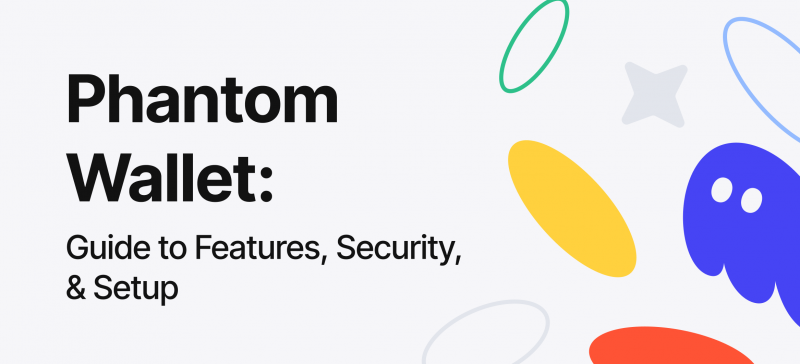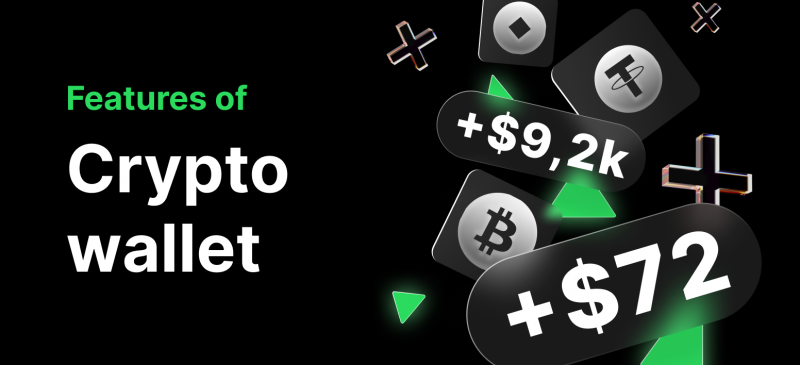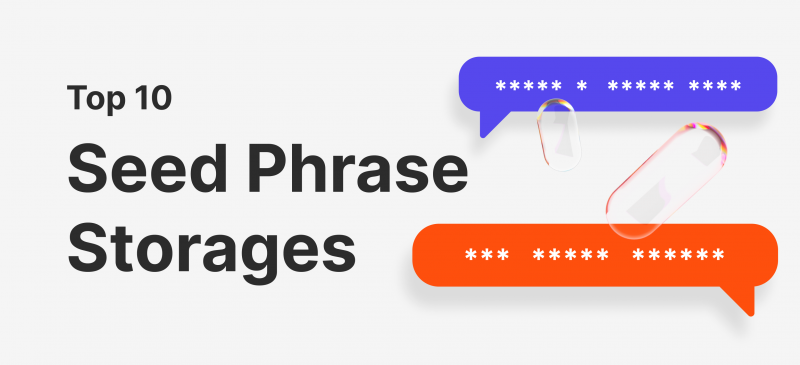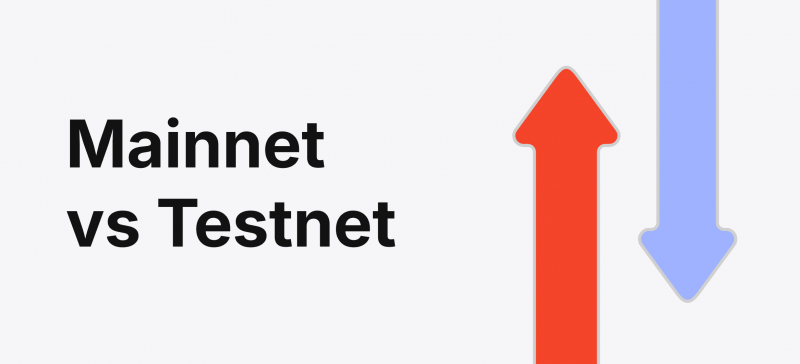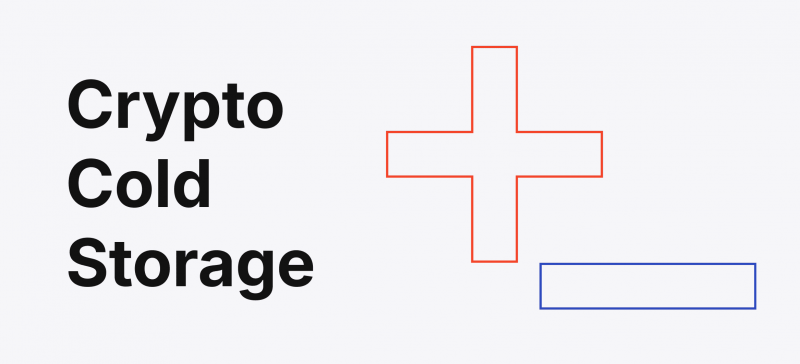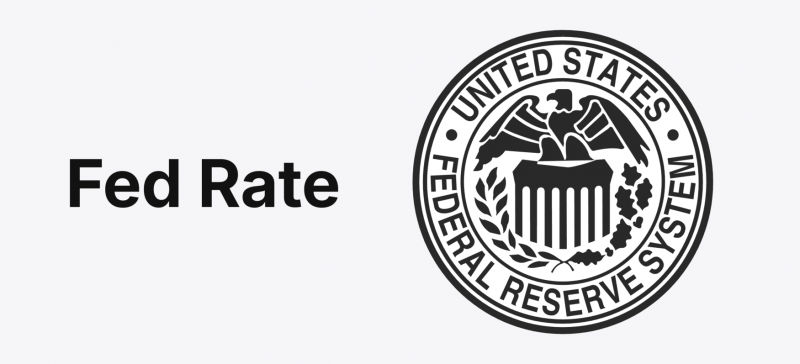In the dynamic world of cryptocurrency, where digital assets are as valuable as they are volatile, choosing the right wallet is essential for safeguarding your investments. Phantom Wallet, renowned for its seamless integration with the Solana blockchain and expanding support for other networks, has quickly become a favorite among crypto enthusiasts.
This article explores Phantom Wallet’s features, offers essential tips and insights to help you ensure your digital treasures remain secure and accessible, and provides a step-by-step guide on how to install and set up Phantom Wallet.
Key Takeaways
- Phantom Wallet supports multiple blockchains, including Solana, Ethereum, Polygon, and Bitcoin.
- The wallet offers both mobile and browser extension versions.
- Phantom Wallet is known for its strong security measures, including non-custodial design, biometric authentication, and integration with Ledger hardware wallets.
- It features a competitive fee structure, with no charges for creating a wallet and low transaction fees.
What is a Phantom Wallet?
Phantom Wallet is a cutting-edge Web3 wallet initially built for the Solana blockchain, but it has rapidly evolved into a multi-chain solution supporting Ethereum, Polygon, and Bitcoin networks. Launched in 2021, Phantom Wallet quickly became a favorite among cryptocurrency users due to its user-friendly interface, robust security features, and comprehensive support for dApps and NFTs.
Accessible as both a mobile app and a browser extension, Solana Phantom Wallet allows users to seamlessly store, send, and receive cryptos, manage their NFT collections, and engage with various dApps directly from the wallet interface. Its integration with multiple blockchains provides users with the flexibility to manage assets across different networks, all within a single platform. This multi-chain capability, combined with its in-app token swap feature, makes Phantom Wallet a powerful tool for anyone looking to manage a diverse crypto portfolio with ease.
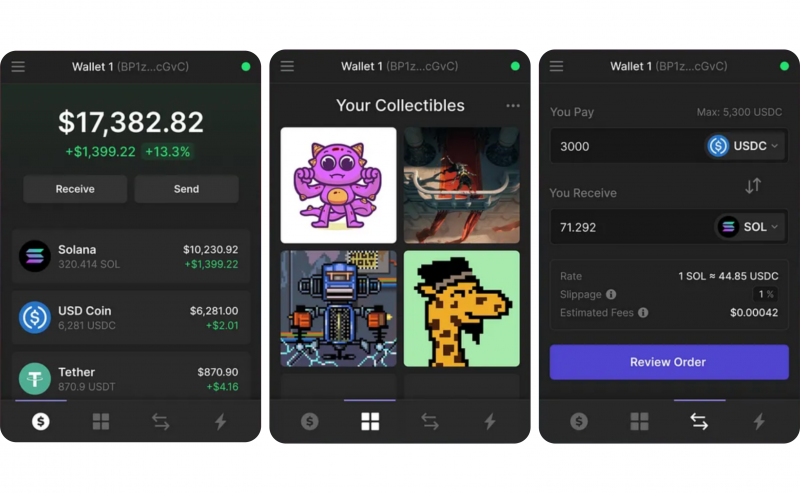
Phantom Wallet prioritizes security, employing a non-custodial approach that ensures users retain full control over their private keys. This self-custodial model is complemented by features such as scam detection, encrypted private key storage, and biometric authentication for mobile devices.
Phantom Wallet offers a cost-effective solution for managing digital assets, particularly appealing to users looking for a budget-friendly experience. Unlike many competitors, Phantom does not charge any fees for creating or maintaining a wallet, making it accessible to a broad range of users. When it comes to transactions, the fees are tied to the Solana blockchain’s network costs, which are notably low compared to other blockchains like Ethereum.
For in-app token swaps, Phantom charges a modest fee of 0.85%, which is competitive in the market and covers the convenience of exchanging assets directly within the wallet. This fee structure is designed to be transparent, with no hidden charges, allowing users to manage their assets without worrying about unexpected costs.
Phantom Wallet is an intuitive and robust tool for both novice and experienced users, offering an affordable fee structure and a mission to make decentralized finance accessible to everyone.
Phantom Wallet Review: Key Features
Phantom Wallet stands out as a versatile and secure solution for managing digital assets, with a range of features that cater to both novice and seasoned cryptocurrency users. Its user-friendly interface, combined with robust security measures and multi-chain support, positions it as a top choice in the crowded field of crypto wallets. Let’s delve into some of the key features that make it a top choice in the crypto space.
Solana Staking
One of Phantom Wallet’s standout features is its support for Solana staking, allowing users to actively participate in the Solana network by delegating their SOL tokens to validators. This process not only secures the network but also offers users the opportunity to earn rewards, with Annual Percentage Yields (APY) ranging between 5% to 9%. The wallet simplifies the staking process, making it accessible even to those new to the concept.

Staking through Phantom Wallet is straightforward: users lock their SOL tokens with a chosen validator, and in return, they receive staking rewards. These rewards are compounded over time, which can lead to significant earnings, especially for long-term holders.
However, it’s important to note that users must ensure they have sufficient SOL in their wallet to cover gas fees when they decide to unstake their tokens. Failing to do so can result in transaction failures, which can be frustrating. Nevertheless, the staking feature in Phantom Wallet is a great way for users to grow their assets while supporting the Solana ecosystem.
NFT Support
Phantom Wallet has also embraced the growing popularity of NFTs, providing users with a robust platform to store, manage, and trade their digital collectibles. The wallet automatically groups similar NFTs, hides spam, and even helps users discover new collections, making it a highly user-friendly tool for NFT enthusiasts.

Moreover, Phantom Wallet offers detailed metadata for each NFT, including floor prices, last sale prices, and total returns, which is invaluable for collectors and traders who want to make informed decisions.
Phantom Wallet’s NFT integration doesn’t stop at storage. It allows users to connect to multiple NFT marketplaces, including OpenSea, Blur, LooksRare, X2Y2, Magic Eden, and Tensor, and sell their NFTs directly from the wallet. The platform aggregates offers from these marketplaces, ensuring that users get the best possible price for their assets. Additionally, Phantom provides detailed information about each marketplace’s fees and profit/loss estimates, helping users make smart trading decisions.
Non-Custodial Design
Security is a critical concern for any crypto wallet user, and Phantom Wallet addresses this with its non-custodial design. In a non-custodial wallet, users retain complete control over their private keys, which are essential for accessing their digital assets. This means that there is no third-party involvement, significantly reducing the risk of unauthorized access or asset seizure.
However, this also places the responsibility of safeguarding the seed phrase—a unique set of words that can recover the wallet—squarely on the user. If a user loses their seed phrase, recovering the wallet and its assets becomes impossible, highlighting the importance of proper key management.
Phantom Wallet provides a guide on its support website to help users understand and manage their seed phrases. This emphasis on user education and control aligns with the principles of decentralization, empowering Phantom wallet users to manage their assets securely and independently.
Token Swap
Phantom Wallet’s in-app token swap feature is another highlight, offering users a convenient way to exchange cryptocurrencies across different networks. Whether you’re dealing with ETH, Polygon, or Solana, Phantom Wallet allows you to swap tokens directly within the app, streamlining the process and saving time.
Phantom Wallet also supports token bridges, facilitating cross-chain transactions between Solana, Ethereum, and Polygon. This feature enhances the wallet’s versatility, making it a go-to tool for Phantom users who need to manage assets across multiple blockchains. By aggregating liquidity from various DEXs, Phantom ensures that users get the best possible rates for their swaps, further cementing its position as a leading wallet in the crypto space.
Ledger Integration
For users who prioritize security, Phantom Wallet offers integration with Ledger hardware wallets, widely regarded as one of the safest ways to store digital assets. This integration allows users to manage their Solana, Ethereum, and Polygon tokens through Phantom Wallet while keeping their private keys securely stored on their Ledger device. However, it’s important to note that this feature is currently only supported on Chrome, Brave, and Microsoft Edge browsers—not on Firefox or the Phantom mobile apps.
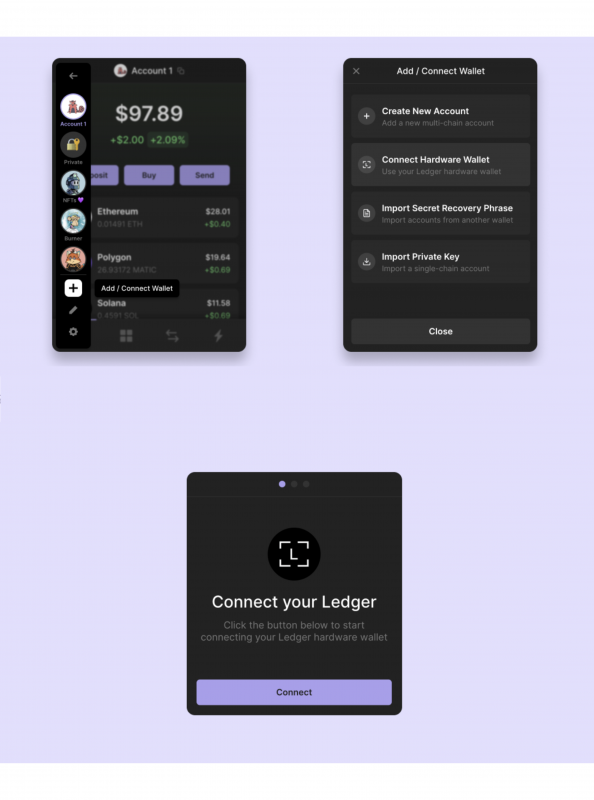
To use this feature, users must first enable “blind signing” on their Ledger device, which is necessary for interacting with smart contracts and dApps. Once set up, users can easily manage their funds across multiple networks, making Ledger integration a valuable addition for those looking to enhance their security measures.
In-App Fiat Purchase
Phantom Wallet also simplifies the process of entering the cryptocurrency market by offering in-app fiat purchases. This feature allows users to buy cryptocurrencies like Ethereum, MATIC, and SOL directly within the wallet using traditional payment methods such as credit cards or bank transfers.
This is particularly useful for new users who may find it daunting to navigate external exchanges or platforms to acquire their first digital assets. By providing a seamless and user-friendly purchasing experience, Phantom Wallet lowers the barrier to entry into the world of cryptocurrencies.
Is Phantom Wallet Secure?
Phantom Wallet is widely regarded as a secure digital wallet, offering robust features to protect users’ assets while maintaining ease of use. Its security architecture integrates with hardware wallets like Ledger, providing an additional layer of physical security by allowing users to store their private keys offline. This integration is especially valuable for those holding significant amounts of cryptocurrency, as it minimizes exposure to online threats.
For mobile users, Phantom Wallet enhances security through biometric authentication, such as fingerprint or facial recognition. This feature ensures that only the authorized user can access the wallet, adding a strong barrier against illegal entry.
Furthermore, the wallet emphasizes the importance of unassailable seed phrase management. Users are encouraged to store their seed phrases securely, as this is the only way to recover the wallet if access is lost. Phantom offers encrypted backup solutions to help users safely store this critical information.
Phantom Wallet’s commitment to security is further evidenced by its open-source nature, which allows for transparency and community scrutiny.
Despite its strong security measures, Phantom Wallet users must remain vigilant. The wallet is non-custodial, meaning users bear full responsibility for their assets. This requires a proactive approach to security, such as being cautious of phishing scams and ensuring safe browsing practices. By combining Phantom Wallet’s robust security features with responsible user behavior, users can confidently manage their digital assets in the evolving crypto landscape.
Phantom runs a bug bounty program, offering up to $50,000 to white hat hackers who discover critical vulnerabilities, incentivizing the identification and resolution of potential security issues before they can be exploited.
How to Install and Set Up the Wallet
Installing and setting up Phantom Wallet is a straightforward process, whether you prefer using a browser extension or a mobile application. Here’s a step-by-step guide to getting started with this popular crypto wallet.
Installing via Browser Extension
The wallet is compatible with major browsers like Chrome, Firefox, Brave, and Edge.
1. Download the Extension: Visit the official Phantom Wallet website and download the Phantom Wallet extension for your preferred browser. It’s crucial to ensure that you’re downloading from the official site to avoid malicious versions.

2. Install the Extension: Once the download is complete, follow your browser’s prompts to install the extension. After installation, you’ll see the Phantom icon in your browser’s toolbar.
3. Create or Restore a Wallet: Upon opening the Phantom extension, you’ll be prompted to either create a new wallet or restore an existing one. For new users, creating a strong password is essential. Existing users can enter their seed phrase to regain access to their wallets.
4. Secure Your Seed Phrase: After setting up your wallet, you’ll receive a seed phrase. This phrase is crucial for wallet recovery, so store it securely. Phantom does not store this information, making it impossible to recover your wallet if you lose the phrase.
5. Grant Permissions: Phantom will request permission to read and change data on all websites. This access is necessary for dApps to function correctly. If you’re concerned about privacy, consider creating a separate browser profile solely for Phantom Wallet activities.
Installing on Mobile Devices
The Phantom Wallet mobile app is available for both Android and iOS devices.
1. Download the App: Visit the official Phantom website or download the app directly from the App Store or Google Play Store to download the Phantom app.
2. Set Up Your Wallet: After installing the app, open it and follow the on-screen instructions to create a new wallet or restore an existing one using your seed phrase.
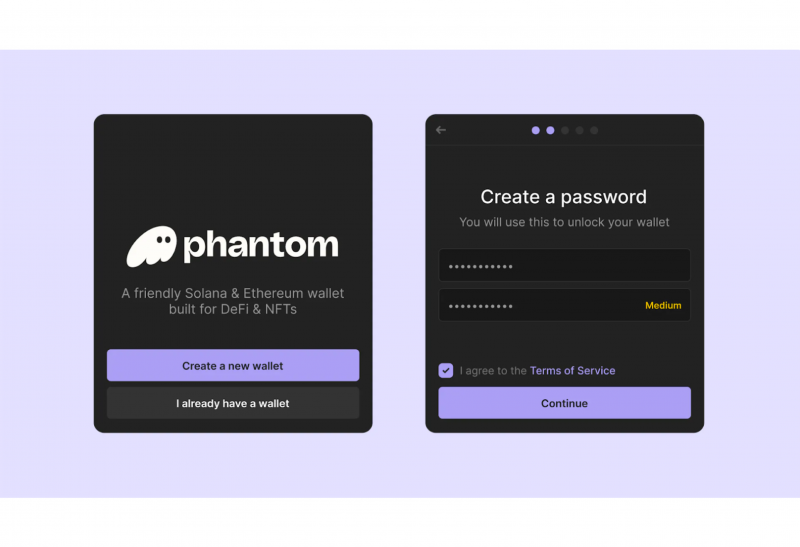
3. Enable Biometric Security: To enhance mobile device security, Phantom Wallet enables biometric authentication, such as fingerprint or facial recognition. This ensures that only you can access your wallet.
4. Secure Your Seed Phrase: Just like the desktop version, the mobile app provides a seed phrase during the initial setup. Store it in a safe place, as losing it means you’ll lose access to your funds.

How to Use: Phantom Wallet Safety Tips and Best Practices
When using Phantom Wallet, security should be your top priority. Although Phantom offers robust security features, the ultimate safety of your digital assets relies on your practices.
First, keep your Secret Recovery Phrase private from others. To further secure your wallet, use a strong, unique password and enable automatic locking to protect your wallet from unauthorized access.
Phantom Wallet users should avoid interacting with unsolicited tokens or NFTs and carefully review the transaction simulation messages provided by the wallet. This helps in identifying potential scams.
Stick to trusted dApps and websites to minimize exposure to phishing attacks or malware.
For added security, consider using two separate wallet accounts—one for everyday Web3 interactions and another solely for storing your assets.
Integrating Ledger hardware wallets with Phantom can provide an extra layer of protection, ensuring your digital assets are secure even when interacting with Web3 platforms.
Finally, regularly revoke wallet access on Ethereum and Solana to maintain control over your wallet’s connections and enhance security.
Bottom Line
Phantom Wallet stands out as a versatile and secure option for managing digital assets across multiple blockchains. With support for Solana, Ethereum, and Polygon, it offers comprehensive features such as token staking, in-app swaps, and NFT management. Its Ledger hardware wallet integration and commitment to robust security practices, including independent audits and scam detection, ensure a high level of safety for users.
As Phantom Wallet continues to expand and innovate, it provides an intuitive interface for both beginners and experienced crypto enthusiasts, making it a reliable choice for navigating the evolving world of decentralized finance (DeFi).
FAQ
How to access Phantom Wallet?
To access Phantom Wallet, install the browser extension from the official Phantom website or download the mobile app, then create or restore your wallet using your seed phrase and secure it with a strong password or bio authentication.
How to cash out on Phantom Wallet?
To cash out on Phantom Wallet, transfer your assets to a CEX or a crypto trading platform that supports the tokens you hold, and then follow the exchange’s process to convert them into fiat currency.
Is Phantom Wallet legit?
Yes, Phantom Wallet is a legitimate and secure digital wallet that is widely used to manage assets on the Solana blockchain and other supported networks. It has robust security features and independent audits.
